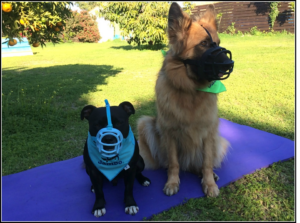Barks Blog
Why It’s Important to Teach Your Dog to Love Wearing a Muzzle
By Maureen Backman, MS, CTC, PCT-A of The Muzzle Up Project

How wonderful would it be if dogs were conditioned to love wearing their muzzles early on so that if they needed to wear one later in life, it would not be an aversive event for them?
The following scenarios illustrate why muzzle training is important for every dog:
Aggression
If he bites, I’ll muzzle train him.
All dogs have the ability to bite. Most dogs display various warning signals prior to biting. These signals may be obvious, such as snarling or growling, or more subtle, such as ‘freezing’ or a quick flick of the tongue. Signals can happen extremely quickly and may not always be noticeable, so why wait for a bite to occur? When conducted properly, muzzle training will not create additional stress for a dog or interfere with an aggressive dog’s training plan. On the contrary, it ensures both dogs and humans stay safe in the event of management failure. It also protects the aggressive dog from developing a bite history, which carries ramifications that can severely limit quality of life.
If he bites again, I’ll muzzle train him.
If a dog has already bitten another dog or human, muzzle training should be the first priority. Muzzle training does not take the place of a thorough desensitization and counterconditioning protocol – as well as possible pharmacological intervention – to help reduce a biting dog’s fear and aggressive behavior, but it does prevent unnecessary suffering.
Puppies
My dog is a puppy. Why would he need a muzzle?
Puppy training is all about socialization. The goal is to prevent future behavior problems by giving the puppy positive, safe experiences with as many different people, dogs and stimuli as possible. Often, muzzle training is left out of the socialization mix. While puppies don’t need muzzles, the socialization window is a prime opportunity to form early, long-lasting positive associations with a muzzle and handling around the face. Most puppy classes now focus on desensitization to nail clippers, brushes, vacuum cleaners, and more. It’s time to add muzzles to the mix.
The Veterinarian
My dog already hates the vet.
Many dogs are afraid of the veterinarian. The fact that at many veterinarian’s offices they need to be taken “to the back” to be restrained and muzzled for various procedures, often adds to that fear. While muzzle training will not erase the fear of various veterinary procedures, it is still a critical component to any fear-free vet training program in that training a dog to love his muzzle lowers one of the many stressful components of a vet visit. Instead of having to wear a cloth muzzle, guardians can bring the dog’s usual muzzle – the one loaded with positive associations – with them. Eliminating chances of a bite helps vets and technicians perform a more thorough examination, reduces the need for anesthesia for certain procedures, and also opens the door to do further desensitization and counterconditioning to all types of procedures and restraint.
The “Normal” Dog
My dog doesn’t bite. He doesn’t need a muzzle.
Every dog has the ability to bite. The chance of a bite increases manifold when a dog is in pain or injured. By pre-training a non-aggressive, socialized dog to love wearing a muzzle, guardians can act to prevent additional suffering if their dog has an emergency, instead of stacking a new stressor onto an already stressful situation.
Remember: Desensitization and counterconditioning help a dog to enjoy wearing a muzzle and realize that muzzles predict snacks, walks, and a myriad of other good things in life. With a properly fitting basket muzzle in place, that risk of damage, of litigation, and threat to public safety greatly diminishes.
This information is also available as a PPG Educational Handout .

